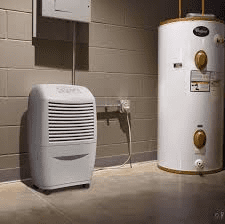The mild spring conditions Toronto residents have recently experienced is a welcome retreat from the harsh bitter winter we’ve just endured. The spring thaw has eradicated most if not all of those unsightly snow banks, which gives Torontoers a clear indication that spring has finally arrived. There are likely numerous spring maintenance items on your checklist but keeping your basement dry is a critical component of home maintenance to fight against basement leaks, mould and overall property damage. With the weather warming up outside your home, internal temperatures will need to be adjusted, and so will humidity levels. Warmer climate holds more moisture in the air and this affect can be felt inside the home, especially in the basement where humidity levels are highest. If you’ve noticed changes in your home’s air quality, it might be time for a dehumidifier which is one of the simplest yet most commonly overlooked basement waterproofing devices which can help ensure a dry basement throughout spring, summer, and year round.
 Photo courtesy of ajmadison.com
Photo courtesy of ajmadison.comA dehumidifier decreases the humidity levels by drying the air. Having a dehumidification system is not only an asset for your basement, but for your entire home’s air quality. Even if you perceive your basement to be completely dry, a dehumidifier is capable of drying out moisture which is deeply imbedded within the small cracks of your basement and foundation. Left untreated, even small amounts of moisture can erode cracks and result in mould and mildew build-up beneath your crawl space and within your basement foundation. Dehumidifiers are an essential component of [interior basement waterproofing](https://www.citywidegroup.com/waterproofing/interior-waterproofing).
 Photo courtesy of Decoist.com
Photo courtesy of Decoist.comOnce it’s been established that you need a dehumidifier for your basement, either due to obvious signs of moisture like when you smell mustiness, or not so obvious indicators like a humidity metre, there are really 2 types of dehumidification systems you can choose from; a condenser dehumidification system or a venting dehumidification system.
 Photo courtesy of Wikipedia.org
Photo courtesy of Wikipedia.orgCondenser systems dry your basement by pulling the moist air and converting it to water. This collected water is considered a rather clean kind of greywater; not suitable for drinking, but acceptable for watering plants, though not garden vegetables. Some designs such as the ionic membrane dehumidifier disposes of the excess water in a vapour rather than liquid form. Most models require manual emptying of the drip output, and are equipped with sensors to detect overflow. Other models can be adapted to connect drip output directly to a drain via an ordinary garden hose. Some can even tie into plumbing drains or use a built-in water pump to empty themselves as they collect moisture.
Venting dehumidifiers skip the process of condensing the moisture into water; making them more energy efficient. They decrease humidity by venting the moist air back outside before it rises to the other levels of your house. Venting systems also have the advantage of dehumidifying and filtering your air at the same time, eliminating odour problems in your basement. Venting dehumidifiers have a powerful blowing motor that is strong enough to duct air into a finished basement space, while the unit itself can be tucked away in an unfinished part of your basement. Be sure to consult with basement waterproofing professionals for help in deciding which dehumidifier is right for your basements needs.










